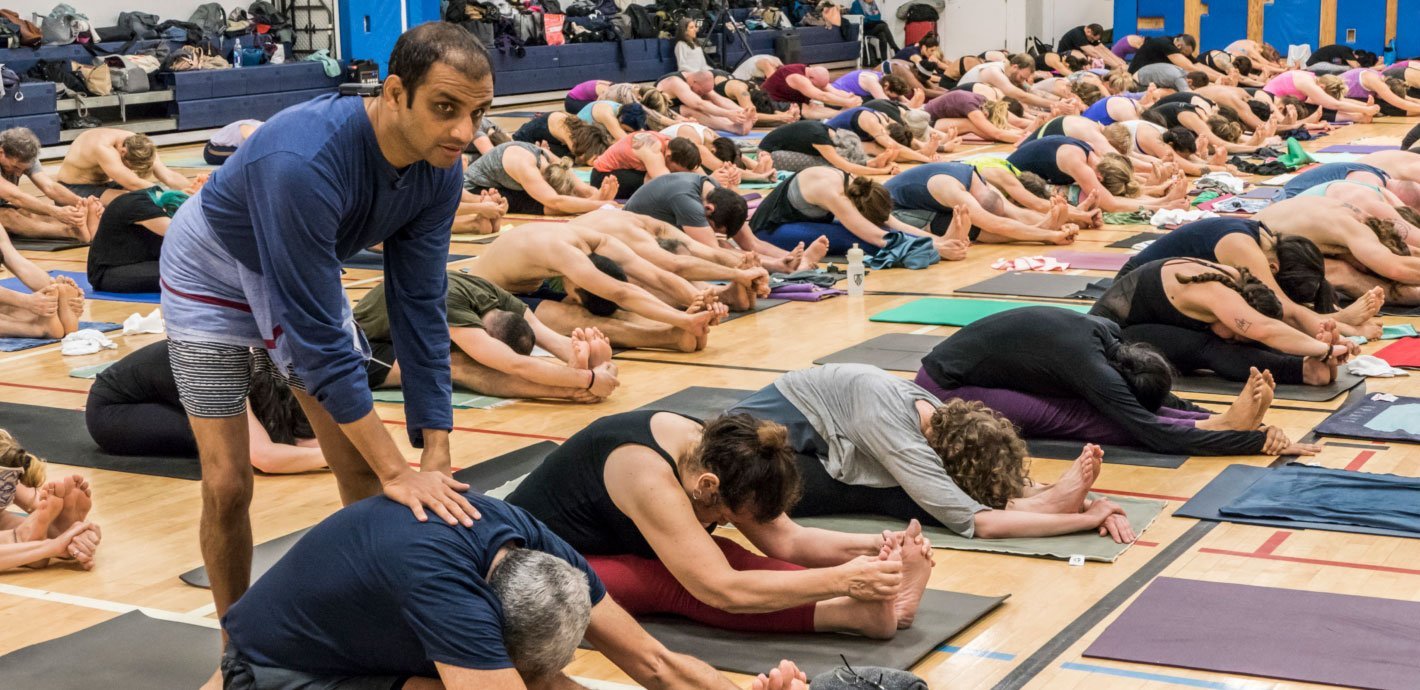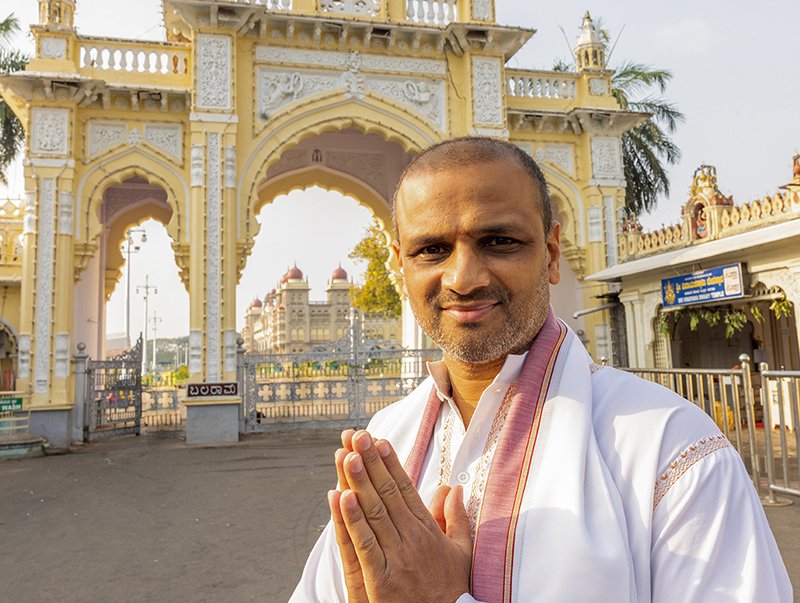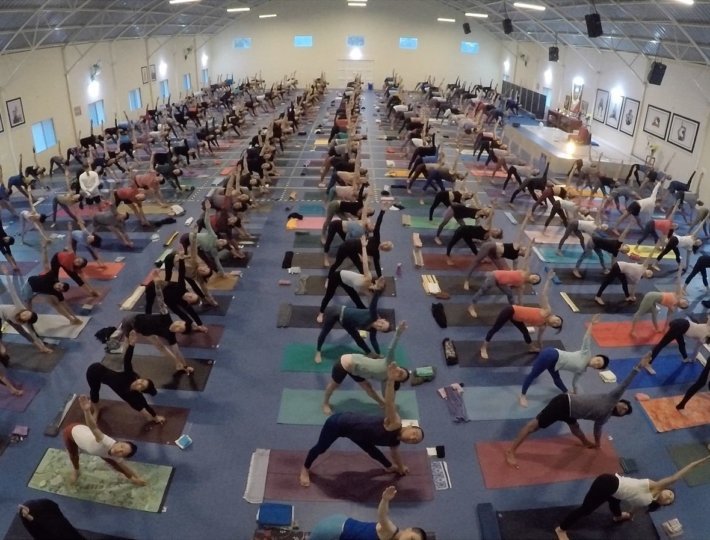It is very important to have a connection to a local yoga shala. For one thing, a shala motivates you. You see others practicing and you feel like practicing. When students practice at home, especially beginners, it’s easy to become distracted or to have interruptions. But at a shala, a teacher has created a space to practice with a certain energy. He or she guides the student and, thus, the valuable student-teacher relationship begins.
The student-teacher relationship is well defined in India’s ancient texts and, oftentimes, before we engage in any teachings, we chant the mantra found in the Upanishads:
Om sahana vavatu, sahanau bhunaktu
Saha veeryam karavaa vahai
Tejasvi naa vadhee tamastu maa vidvishaa vahai
Om Shaanti Shaanti Shaantihi
Translation:
May he protect us both (the teacher and the student).
May he nourish us both.
May we both work together with great energy.
May our study be enlightening and fruitful.
May we not hate each other.
Om Peace, Peace, Peace.
Sahana means together and, in this chant, we ask the teacher, together with the student, to maintain a certain calmness or tolerance toward each other. After many years of practice and sadhana, the teacher has certain knowledge, and for a student to grasp that knowledge his or her involvement is very important. It’s as simple as if the teacher offers community service, then his or her students should try to help this effort. This mutual understanding, support, and tolerance must be there for the knowledge to exchange hands.
Though we do physical asana at a yoga shala, it is far different from working out at a gym. In gyms, you pay money, you work out, and there is no connection. This is not the same for yoga. Yoga implies that there is a connection between the student and teacher. At a shala, the teacher monitors your practice and postures with which you need help; students also learn from other students. Maybe they are more advanced than you, more focused, or more disciplined, but together, with the teacher, everyone is creating good energy, which you practice in a shala.
In many respects, a yoga shala is not unlike a temple, or a place of worship where we go to get connected, detach from material things, and dedicate our efforts to a practice. At temples and churches, the priests have devoted their lives to spirituality. They get up early every day to do puja, and they develop a certain type of environment that worshipers feel as soon as they enter. In this sacred place, people can forget their troubles at home, at work, and in their social life. They can be themselves and feel closer to the divine. You can pray at home, but it’s stronger when you go to a temple. Yoga is similar.
Related: Sharath Jois on the Importance of Having a Yoga Teacher
With a good teacher, we can surrender to learning and a positive energy flows within us. When I say surrender, I’m suggesting that students be open to the teachings, otherwise, you will be blocked. Without any particular agenda, you should try to learn from a teacher. If a student thinks he knows everything, or more than the teacher, then the energy will not flow from teacher to student. Yoga is a seeking path; you seek and learn new things all the time. It’s not about saying, “I know everything.” In fact, “I” should be deleted from yoga. If you are this kind of person, then your ego will block your spiritual progress.
One of the first ways people experience change is by following simple disciplines. Yoga isn’t dominated by one interpretation, but to experience true yoga there are consistent yogic principles, or disciplines, found throughout the great bodies of Vedic texts that people should follow.
A shala that has certain disciplines, or principles, helps facilitate discipline within you. A very basic example is that when you go to a shala for daily practice, you’ll get a time slot or a window of time to start and stop practice. Let’s say your time is 7 a.m.. So you get up at 6 a.m. and take a bath. You start to watch what you eat the night before, and when you’re eating. Yoga becomes more than just bending the body. Your overall health begins to improve because your life has become more principled. It happens slowly over time, but it’s these disciplines that will guide you on your spiritual journey.
Many people go to ashrams to help adopt discipline and listen to lectures, or satsangs, from a swami or a spiritual leader. They go to get good thoughts and when you get good thoughts, your actions will also be good. In this respect, a shala is also like an ashram. Teachers in ashrams have dedicated their lives to the practice. They wake up very early and dedicate themselves to their students. They want their students to experience the good that they’ve experienced.
When you find the right yoga environment, it draws you in. Automatically, your mind, body, and soul want to return to practice. How the space is cultivated is dependent upon the teacher; if there’s gossiping and talking nonsense, then that kind of culture will manifest, and there will be little transformation. If a teacher creates a spiritual environment with spiritual talks and thoughts, then a student’s mind will transform in many ways. Which also doesn’t happen sitting at home alone.
Photography by Tom Rosenthal








Comments (0)